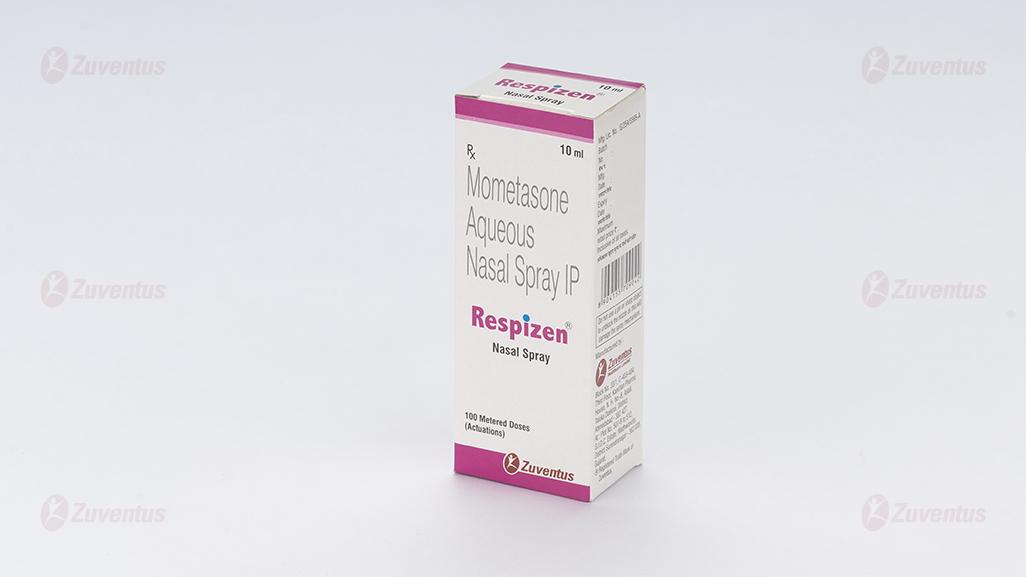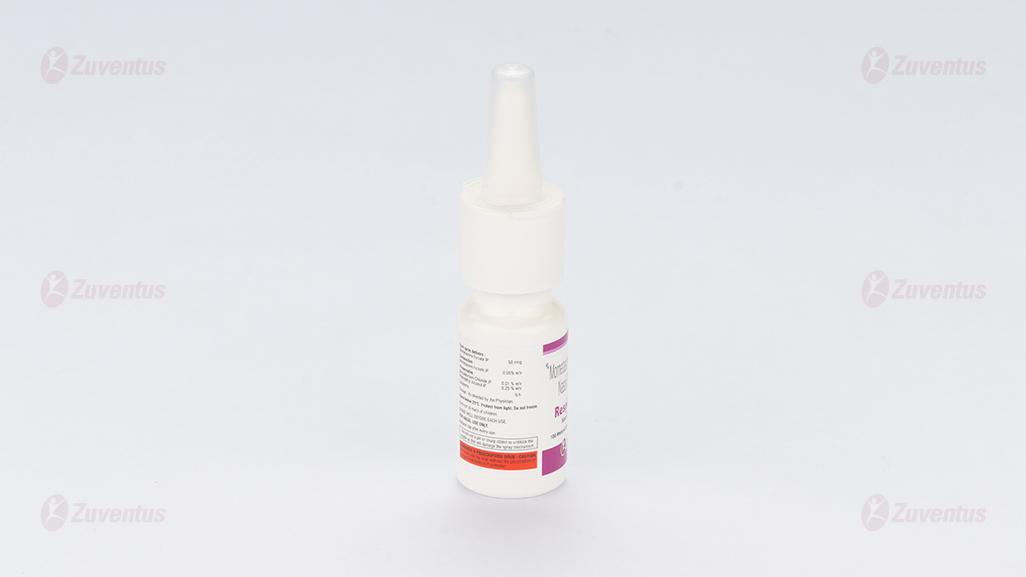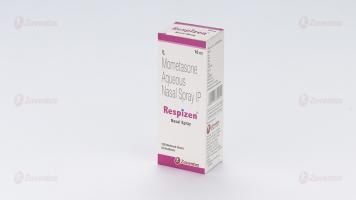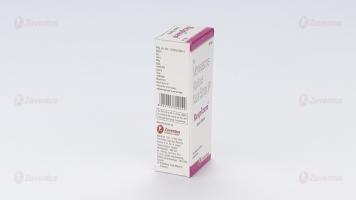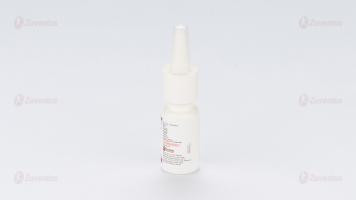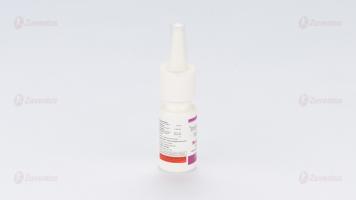Respizen Nasal Spray
Therapy Area
Respiratory
1.0 Generic Name
Mometasone Aqueous Nasal Spray
2.0 Qualitative and Quantitative Composition
Each spray delivers:
Mometasone Furoate IP 50 mcg
Composition:
Mometasone Furoate IP…………………. 0.05% w/v
Preservative:
Benzalkonium Chloride IP……………… 0.01 % w/v
Phenylethyl Alcohol IP…………………. 0.25 % w/v
Excipients q.s.
3.0 Dosage Form and Strength
Nasal spray Each spray delivers Mometasone Furoate 50 mcg
4.0 Clinical Particulars
4.1 Therapeutic indication
- For treatment of symptoms of seasonal or perennial rhinitis in adults only.
- For the treatment of nasal symptoms of seasonal allergic and perennial allergic rhinitis, in adults and paediatric patients 2 years of age and older.
4.2 Posology and method of administration
Seasonal Allergic or Perennial Rhinitis
Adults (including older patients) and children 12 years of age and older
The usual recommended dose is two actuations (50 micrograms/actuation) in each nostril once daily (total dose 200 micrograms). Once symptoms are controlled, dose reduction to one actuation in each nostril (total dose 100 micrograms) may be effective for maintenance. If symptoms are inadequately controlled, the dose may be increased to a maximum daily dose of four actuations in each nostril once daily (total dose 400 micrograms). Dose reduction is recommended following control of symptoms.
Paediatric population
Children between the ages of 2 and 11 years
The usual recommended dose is one actuation (50 micrograms/actuation) in each nostril once daily (total dose 100 micrograms).
Mometasone furoate nasal spray, suspension demonstrated a clinically significant onset of action within 12 hours after the first dose in some patients with seasonal allergic rhinitis; however, full benefit of treatment may not be achieved in the first 48 hours. Therefore, the patient should continue regular use to achieve full therapeutic benefit.
Treatment with mometasone furoate nasal spray, suspension may need to be initiated some days before the expected start of the pollen season in patients who have a history of moderate to severe symptoms of seasonal allergic rhinitis.
Paediatric population
Seasonal Allergic Rhinitis and Perennial Rhinitis
The safety and efficacy of mometasone furoate nasal spray in children under 2 years of age have not been established.
Method of administration
Prior to administration of to the first dose, shake container well.
After initial priming of the Mometasone furoate nasal spray, suspension pump (usually 10 actuations, until a uniform spray is observed), each actuation delivers approximately 100 mg of mometasone furoate suspension, containing mometasone furoate monohydrate equivalent to 50 micrograms mometasone furoate. If the pump is not used for 14 days or longer, reprime the pump with 2 actuations, a uniform spray is observed, before next use.
Shake container well before each use. The bottle should be discarded after the labelled number of actuations or within 2 months of first use.
Do not use a pin or sharp object to unblock the nozzle as this will damage the spray mechanism.
4.3 Contraindications
- Hypersensitivity to Mometasone furoate or to any of the excipients listed in the formulation.
- Mometasone furoate nasal spray should not be used in the presence of untreated localized infection involving the nasal mucosa, such as herpes simplex.
- Because of the inhibitory effect of corticosteroids on wound healing, patients who have experienced recent nasal surgery or trauma should not use a nasal corticosteroid until healing has occurred.
4.4 Special warnings and precautions for use
Immunosuppression
Mometasone furoate nasal spray, suspension should be used with caution, if at all, in patients with active or quiescent tuberculous infections of the respiratory tract, or in untreated fungal, bacterial or systemic viral infections. Patients receiving corticosteroids who are potentially immunosuppressed should be warned of the risk of exposure to certain infections (e.g., chickenpox, measles) and of the importance of obtaining medical advice if such exposure occurs.
Local Nasal Effects
Following 12 months of treatment with mometasone furoate nasal spray, suspension in a study of patients with perennial rhinitis, there was no evidence of atrophy of the nasal mucosa; also, mometasone furoate tended to reverse the nasal mucosa closer to a normal histologic phenotype. Nevertheless, patients using mometasone furoate nasal spray, suspension over several months or longer should be examined periodically for possible changes in the nasal mucosa. If localised fungal infection of the nose or pharynx develops, discontinuance of mometasone furoate nasal spray, suspension therapy or appropriate treatment may be required. Persistence of nasopharyngeal irritation may be an indication for discontinuing mometasone furoate nasal spray, suspension.
Mometasone furoate is not recommended in case of nasal septum perforation.
In clinical studies, epistaxis occurred at a higher incidence compared to placebo. Epistaxis was generally self-limiting and mild in severity.
Mometasone furoate nasal spray, suspension contains benzalkonium chloride which may cause irritation or swelling inside the nose, especially if used for a long time.
Systemic Effects of Corticosteroids
Systemic effects of nasal corticosteroids may occur, particularly at high doses prescribed for prolonged periods. These effects are much less likely to occur than with oral corticosteroids and may vary in individual patients and between different corticosteroid preparations. Potential systemic effects may include Cushing's syndrome, Cushingoid features, adrenal suppression, growth retardation in children and adolescents, cataract, glaucoma and more rarely, a range of psychological or behavioral effects including psychomotor hyperactivity, sleep disorders, anxiety, depression or aggression (particularly in children).
Following the use of intranasal corticosteroids, instances of increased intraocular pressure have been reported.
Patients who are transferred from long-term administration of systemically active corticosteroids to mometasone furoate nasal spray, suspension require careful attention. Systemic corticosteroid withdrawal in such patients may result in adrenal insufficiency for a number of months until recovery of HPA axis function. If these patients exhibit signs and symptoms of adrenal insufficiency or symptoms of withdrawal (e.g., joint and/or muscular pain, lassitude, and depression initially) despite relief from nasal symptoms, systemic corticosteroid administration should be resumed and other modes of therapy and appropriate measures instituted. Such transfer may also unmask pre-existing allergic conditions, such as allergic conjunctivitis and eczema, previously suppressed by systemic corticosteroid therapy.
Treatment with higher than recommended doses may result in clinically significant adrenal suppression. If there is evidence for higher than recommended doses being used, then additional systemic corticosteroid cover should be considered during periods of stress or elective surgery.
Effect on Growth in Paediatric Population
It is recommended that the height of children receiving prolonged treatment with nasal corticosteroids is regularly monitored. If growth is slowed, therapy should be reviewed with the aim of reducing the dose of nasal corticosteroid if possible, to the lowest dose at which effective control of symptoms is maintained. In addition, consideration should be given to referring the patient to a paediatric specialist.
Non-nasal Symptoms
Although mometasone furoate nasal spray, suspension will control the nasal symptoms in most patients, the concomitant use of appropriate additional therapy may provide additional relief of other symptoms, particularly ocular symptoms.
Visual disturbance
Visual disturbance may be reported with systemic and topical (including, intranasal, inhaled and intraocular) corticosteroid use. If a patient present with symptoms such as blurred vision or other visual disturbances, the patient should be considered for referral to an ophthalmologist for evaluation of possible causes which may include cataract, glaucoma or rare diseases such as central serous chorioretinopathy (CSCR) which have been reported after use of systemic and topical corticosteroids.
4.5 Drugs interactions
Co-treatment with CYP3A inhibitors, including cobicistat-containing products, is expected to increase the risk of systemic side-effects. The combination should be avoided unless the benefit outweighs the increased risk of systemic corticosteroid side-effects, in which case patients should be monitored for systemic corticosteroid side-effects.
A clinical interaction study was conducted with loratadine. No interactions were observed.
4.6 Use in special populations
Pregnancy
There are no or limited amount of data from the use of mometasone furoate in pregnant women. Studies in animals have shown reproductive toxicity. As with other nasal corticosteroid preparations, mometasone furoate nasal spray, suspension should not be used in pregnancy unless the potential benefit to the mother justifies any potential risk to the mother, foetus or infant.
Infants born of mothers who received corticosteroids during pregnancy should be observed carefully for hypoadrenalism.
Breast-feeding
It is unknown whether mometasone furoate is excreted in human milk. As with other nasal corticosteroid preparations, a decision must be made whether to discontinue breast-feeding or to discontinue/abstain from mometasone furoate nasal spray, suspension therapy taking into account the benefit of breast feeding for the child and the benefit of therapy for the woman.
Fertility
There are no clinical data concerning the effect of mometasone furoate on fertility. Animal studies have shown reproductive toxicity, but no effects on fertility.
4.7 Effects on ability to drive and use machines
No studies on the effects on the ability to drive and use machines have been performed.
4.8 Undesirable effects
Epistaxis was generally self-limiting and mild in severity. Systemic effects of nasal corticosteroids may occur, particularly when prescribed at high doses for prolonged periods.
Tabulated list of adverse reactions

Paediatric population
In the paediatric population, the recorded adverse events are epistaxis, headache, nasal irritation and sneezing.
Reporting of suspected adverse reactions
Reporting suspected adverse reactions after authorisation of the medicinal product is important. It allows continued monitoring of the benefit/risk balance of the medicinal product. Healthcare professionals are asked to report any suspected adverse reactions via email to: medico@zuventus.com
By reporting side effects, you can help provide more information on the safety of this medicine.
4.9 Overdose
Symptoms
Inhalation or oral administration of excessive doses of corticosteroids may lead to suppression of HPA axis function.
Management
Because of the negligible (≤ 0.1%) systemic bioavailability of mometasone furoate nasal spray, suspension overdose is unlikely to require any therapy other than observation, followed by initiation of the appropriate prescribed dosage.
5.0 Pharmacological Properties
5.1 Mechanism of Action
Mometasone furoate is a topical glucocorticosteroid with local anti-inflammatory properties at doses that are not systemically active.
It is likely that much of the mechanism for the anti-allergic and anti-inflammatory effects of mometasone furoate lies in its ability to inhibit the release of mediators of allergic reactions. Mometasone furoate significantly inhibits the release of leukotrienes from leucocytes of allergic patients.
In cell culture, mometasone furoate demonstrated high potency in inhibition of synthesis and release of IL-1, IL-5, IL-6 and TNFα; it is also a potent inhibitor of leukotriene production. In addition, it is an extremely potent inhibitor of the production of the Th2 cytokines, IL-4 and IL-5, from human CD4+ T-cells.
5.2 Pharmacodynamic properties
In studies utilising nasal antigen challenge, mometasone furoate nasal spray, suspension has shown anti-inflammatory activity in both the early- and late - phase allergic responses. This has been demonstrated by decreases (vs placebo) in histamine and eosinophil activity and reductions (vs baseline) in eosinophils, neutrophils, and epithelial cell adhesion proteins.
In 28% of the patients with seasonal allergic rhinitis, mometasone furoate nasal spray, suspension demonstrated a clinically significant onset of action within 12 hours after the first dose. The median (50%) onset time of relief was 35.9 hours.
5.3 Pharmacokinetic properties
Absorption
Mometasone furoate, administered as an aqueous nasal spray, has a systemic bioavailability of < 1% in plasma, using a sensitive assay with a lower quantitation limit of 0.25 pg/ml.
Distribution
Not applicable as mometasone is poorly absorbed via the nasal route.
Biotransformation
The small amount that may be swallowed and absorbed undergoes extensive first-pass hepatic metabolism.
Elimination
Absorbed mometasone furoate is extensively metabolized and the metabolites are excretedin urine and bile.
6.0 Nonclinical Properties
6.1 Animal Toxicology or Pharmacology
No toxicological effects unique to mometasone furoate exposure were demonstrated. All observed effects are typical of this class of compounds and are related to exaggerated pharmacologic effects of glucocorticoids.
Preclinical studies demonstrate that mometasone furoate is devoid of androgenic, antiandrogenic, estrogenic or antiestrogenic activity but, like other glucocorticoids, it exhibits some antiuterotrophic activity and delays vaginal opening in animal models at high oral doses of 56 mg/kg/day and 280 mg/kg/day.
Like other glucocorticoids, mometasone furoate showed a clastogenic potential in-vitro at high concentrations. However, no mutagenic effects can be expected at therapeutically relevant doses.
In studies of reproductive function, subcutaneous mometasone furoate, at 15 micrograms/kg prolonged gestation and prolonged and difficult labour occurred with a reduction in offspring survival and body weight or body weight gain. There was no effect on fertility.
Like other glucocorticoids, mometasone furoate is a teratogen in rodents and rabbits. Effects noted were umbilical hernia in rats, cleft palate in mice and gallbladder agenesis, umbilical hernia, and flexed front paws in rabbits. There were also reductions in maternal body weight gains, effects on foetal growth (lower foetal body weight and/or delayed ossification) in rats, rabbits and mice, and reduced offspring survival in mice.
The carcinogenicity potential of inhaled mometasone furoate (aerosol with CFC propellant and surfactant) at concentrations of 0.25 to 2.0 micrograms/l was investigated in 24-month studies in mice and rats. Typical glucocorticoid-related effects, including several non-neoplastic lesions, were observed. No statistically significant dose-response relationship was detected for any of the tumour types.
7.0 Description
Mometasone furoate, the active component of Respizen Nasal Spray, 50 mcg, is an anti-inflammatory corticosteroid having the chemical name, 9,21-Dichloro-11ß,17-dihydroxy-16α-methylpregna-1,4-diene-3,20-dione17-(2 furoate) monohydrate, and the following chemical structure:

Molecular formula: C27H30Cl2O6•H2O
Molecular weight: 539.45.
8.0 Pharmaceutical particulars
8.1 Shelf-life
Refer on pack
8.2 Storage and handing instructions
Store below 25°C. Protect from light. Do not freeze.
Keep out of reach of children.
SHAKE WELL BEFORE EACH USE.
FOR NASAL USE ONLY.
Replace cap after every use.
9.0 Patient Counselling Information
Local Nasal Effect
Patients should be informed that treatment with RESPIZEN Nasal Spray 50 mcg may be associated with adverse reactions which include epistaxis (nose bleed) and nasal septum perforation. Candida infection may also occur. Because of the inhibitory effect of corticosteroids on wound healing, patients who have experienced recent nasal septum ulcers, nasal surgery, or nasal trauma should not use a nasal corticosteroid until healing has occurred. Patients should be cautioned not to spray RESPIZEN Nasal Spray 50 mcg directly onto the nasal septum.
Glaucoma and Cataracts
Patients should be informed that nasal and inhaled corticosteroids may result in the development of glaucoma and/or cataracts. Therefore, close monitoring is warranted in patients with a change in vision or with a history of increased intraocular pressure, glaucoma, and/or cataracts. Patients should be cautioned not to spray RESPIZEN Nasal Spray 50 mcg into the eyes.
Immunosuppression
Persons who are on immunosuppressant doses of corticosteroids should be warned to avoid exposure to chickenpox or measles, and patients should also be advised that if they are exposed, medical advice should be sought without delay.
Use Regularly for Best Effect
Patients should use RESPIZEN Nasal Spray 50 mcg on a regular basis for optimal effect. Improvement in nasal symptoms of allergic rhinitis has been shown to occur within 1 to 2 days after initiation of dosing. Maximum benefit is usually achieved within 1 to 2 weeks after initiation of dosing. Patients should not increase the prescribed dosage but should contact their physician if symptoms do not improve, or if the condition worsens. Administration to young children should be aided by an adult.
If a patient missed a dose, the patient should be advised to take the dose as soon as they remember. The patient should not take more than the recommended dose for the day.
12.0 Date of revision
09.10.2024
Please read this leaflet carefully before you start using this medicine because it contains important information for you.
- Keep this leaflet. You may need to read it again.
- If you have any further questions, ask your doctor or pharmacist.
- This medicine has been prescribed for you. Do not pass it on to others. It may harm them, even if their signs of illness are the same as yours.
- If you get any side effects, talk to your doctor or pharmacist. This includes any possible side effects not listed in this leaflet.
What is in this leaflet
1. What Respizen is and what it is used for
2. What you need to know before you use Respizen
3. How to use Respizen
4. Possible side effects
5. How to store Respizen
6. Contents of the pack and other information
1. What Respizen is and what it is used for
What is Respizen?
Respizen Nasal Spray contains mometasone furoate, one of a group of medicines called corticosteroids. When mometasone furoate is sprayed into the nose, it can help to relieve inflammation (swelling and irritation of the nose), sneezing, itching and a blocked up or runny nose.
What is Respizen used for?
Hay fever and perennial rhinitis
Respizen is used to treat the symptoms of hay fever (also called seasonal allergic rhinitis) and perennial rhinitis in adults and children aged 3 and older.
Hay fever, which occurs at certain times of the year, is an allergic reaction caused by breathing in pollen from trees, grasses, weeds and also moulds and fungal spores. Perennial rhinitis occurs throughout the year and symptoms can be caused by a sensitivity to a variety of things including house dust mite, animal hair (or dander), feathers and certain foods. Respizen reduces the swelling and irritation in your nose and thereby relieving sneezing, itching and a blocked-up or runny nose caused by hay fever or perennial rhinitis.
Nasal polyps
Respizen is used to treat nasal polyps in adults aged 18 and over.
Nasal polyps are small growths on the lining of the nose and usually affect both nostrils. Respizen reduces the inflammation in the nose, causing the polyps to gradually shrink, thereby relieving a blocked feeling in the nose which may affect breathing through the nose.
2. What you need to know before you use Respizen
Do not use Respizen
- if you are allergic (hypersensitive) to mometasone furoate or any of the other ingredients of this medicine.
- if you have an untreated infection in your nose. Use of Respizen during an untreated infection in your nose, such as herpes, can worsen the infection. You should wait until the infection is resolved before you start using the nasal spray.
- if you have recently had an operation on your nose or you have injured your nose. You should not use the nasal spray until your nose has healed.
Warnings and precautions
Talk to your doctor or pharmacist before using Respizen
- if you have or have ever had tuberculosis.
- if you have any other infection.
- if you are taking other corticosteroid medicines, either by mouth or by injection.
- if you have cystic fibrosis.
While you are using Respizen, talk to your doctor
- if your immune system is not functioning well (if you have difficulty in fighting infection) and you come into contact with anyone with measles or chickenpox. You should avoid coming into contact with anyone who has these infections.
- if you have an infection of the nose or throat.
- if you are using the medicine for several months or longer.
- if you have persistent irritation to the nose or throat.
When corticosteroid nasal sprays are used at high doses for long periods of time, side effects may occur due to the drug being absorbed in the body.
If your eyes are itching or irritated, your doctor may recommend that you use other treatments with Respizen.
Contact your doctor if you experience blurred vision or other visual disturbances.
Children
When used at high doses for long periods of time, corticosteroid nasal sprays may cause certain sideeffects, such as slowed growth rate in children.
It is recommended that the height of children receiving long-term treatment with nasal corticosteroids is regularly monitored and if any changes are noted, their doctor should be notified.
Other medicines and Respizen
Tell your doctor or pharmacist if you are taking, have recently taken or might take any other medicines, including medicines obtained without a prescription.
If you are taking other corticosteroid medicines for allergy, either by mouth or injection, your doctor may advise you to stop taking them once you begin using Respizen. A few people may find that once they discontinue oral or injected corticosteroids they suffer from some undesirable effects, such as joint or muscular pain, weakness and depression. You may also seem to develop other allergies, such as itchy, watering eyes or patches of red and itchy skin. If you develop any of these effects, you should contact your doctor.
Some medicines may increase the effects of Respizen and your doctor may wish to monitor you carefully
if you are taking these medicines (including some medicines for HIV: ritonavir, cobicistat).
Pregnancy and breast-feeding
There is little or no information on the use of Respizen in pregnant women. It is not known if mometasone furoate is found in breast milk.
If you are pregnant or breast-feeding, think you may be pregnant or are planning to have a baby, ask your doctor or pharmacist for advice before taking this medicine.
Driving and using machines
There is no known information on the effect of Respizen on the ability to drive or use machinery.
Respizen contains benzalkonium chloride
Benzalkonium chloride may cause irritation or swelling inside the nose, especially if used for a long time.
3. How to use Respizen
Always use Respizen exactly as your doctor has told you. You should check with your doctor or pharmacist if you are not sure. Do not use a larger dose or use the spray more often or for longer than your doctor tells you to.
Treatment of Hayfever and Perennial Rhinitis
Use in adults and children over 12 years’ old
The usual dose is two sprays into each nostril once a day.
- Once your symptoms are under control, your doctor may advise you to decrease the dose.
- If you do not start to feel any better, you should see your doctor and he or she may tell you to increase the dose; the maximum daily dose is four sprays into each nostril once a day.
Use in children aged 3 to 11 years
The usual dose is one spray into each nostril once daily.
In some patients Respizen begins to relieve symptoms within 12 hours after the first dose; however full benefit of treatment may not be seen in the first two days. Therefore, you should continue regular use to achieve full benefit of treatment.
If you or your child suffer badly from hay fever, your doctor may tell you to start using Respizen some days before the start of the pollen season, as this will help to prevent your hay fever symptoms from occurring.
Nasal Polyps
Use in adults over 18 years’ old
The usual starting dose is two sprays into each nostril once daily.
- If symptoms are not controlled after 5 to 6 weeks, the dose may be increased to two sprays in each nostril twice daily. Once symptoms are under control, your doctor may advise you to decrease your dose.
- If no improvement in symptoms is seen after 5 to 6 weeks of twice daily administration, you should contact your doctor.
Preparing your nasal spray for use
Your Respizen Nasal Spray has a dust cap which protects the nozzle and keeps it clean. Remember to take this off before using the spray and to replace it after use.
If you are using the spray for the first time you need to ‘prime’ the bottle by pumping the spray 10 times until a fine mist is produced:
- Gently shake the bottle.
- Put your forefinger and middle finger either side of the nozzle and your thumb underneath the bottle. Do Not pierce the nasal applicator.
- Point the nozzle away from you and then press down with your fingers to pump the spray 10 times until a fine mist is produced.
If you have not used the spray for 14 days or more, you need to “re-prime” the bottle by pumping the spray 2 times until a fine mist is produced.
How to use your nasal spray
1.Shake the bottle gently and remove the dust cap.
2.Gently blow your nose.
3.Close one nostril and put the nozzle into the other nostril. Tilt your head forward slightly, keeping the bottle upright.
4.Start to breathe in gently or slowly through your nose and whilst you are breathing in squirt a spray of fine mist into your nose by pressing down ONCE with your fingers.
5.Breathe out through your mouth. Repeat step 4 to inhale a second spray in the same nostril if applicable.
6.Remove the nozzle from this nostril and breathe out through the mouth.
7.Repeat steps 3 to 6 for the other nostril.
After using the spray, wipe the nozzle carefully with a clean handkerchief or tissue and replace the dust cap.
Cleaning your nasal spray
- It is important to clean your nasal spray regularly, otherwise it may not work properly.
- Remove the dust cap and gently pull off the nozzle.
- Wash the nozzle and dust cap in warm water and then rinse under a running tap.
- Do not try to unblock the nasal applicator by inserting a pin or other sharp object as this will damage the applicator and cause you not to get the right dose of medicine.
- Allow the dust cap and nozzle to dry in a warm place.
- Push the nozzle back onto the bottle and replace the dust cap. The spray will need to be primed again with 2 sprays when first used after cleaning.
If you use more Respizen than you should
Tell your doctor if you accidentally use more than you were told.
If you use steroids for a long time or in large amounts they may, rarely, affect some of your hormones. In children this may affect growth and development.
If you forget to use Respizen
If you forget to use your nasal spray at the right time, use it as soon as you remember, then carry on as before. Do not take a double dose to make up for a forgotten dose.
If you stop using Respizen
In some patients Respizen should begin to relieve symptoms 12 hours after the first dose; however full benefit of treatment may not be seen for up to two days. It is very important that you use your nasal spray regularly. Do not stop your treatment even if you feel better unless told to do so by your doctor.
If you have any further questions on the use of this product, ask your doctor or pharmacist.
4. Possible side effects
Like all medicines, this medicine can cause side effects, although not everybody gets them.
Immediate hypersensitivity (allergic) reactions may occur after use of this product. These reactions may be severe. You should stop taking Respizen and get immediate medical help if you experience symptoms such as:
- swollen face, tongue or pharynx
- trouble swallowing
- hives
- wheezing or trouble breathing
When corticosteroid nasal sprays are used at high doses for long periods of time, side effects may occur due to the drug being absorbed in the body.
Other side effects
Most people do not have any problems after using the nasal spray. However, some people, after using Respizen or other corticosteroid nasal sprays, may find that they suffer from:
Common side effects (may affect up to 1 in 10 people)
- headache
- sneezing
- nose bleeds [occurred very commonly (may affect more than 1 in 10 people) in people with nasal polyps receiving Respizen two sprays in each nostril twice a day]
- sore nose or throat
- ulcers in the nose
- respiratory tract infection
Not known (frequency cannot be estimated from the available data)
- increase in pressure in the eye (glaucoma) and/or cataracts causing visual disturbances
- damage to the partition in the nose which separates the nostrils
- changes in taste and smell
- difficulty in breathing and/or wheezing
- blurred vision
Reporting of side effects
If you get any side effects, talk to your doctor, pharmacist or nurse. This includes any possible side effects not listed in this leaflet. You can also report side effects directly: Website: www.zuventus.co.in and click the tab “Safety Reporting” located on the top end of the home page. Website link: https://www.zuventus.co.in/drug-safety-reporting By reporting side effects, you can help provide more information on the safety of this medicine. You can also report the side effect with the help of your treating physician.
5. How to store Respizen
- Keep this medicine out of the sight and reach of children.
- Do not store the bottle above 25°C. Do not freeze.
- Do not use this medicine after the expiry date which is stated on the bottle and carton after EXP.
- The expiry date refers to the last day of that month.
- The bottle should be used within 2 months of first opening. Only open one bottle at a time.
Do not throw away any medicines via wastewater or household waste. Ask your pharmacist how to throw away medicines you no longer use. These measures will help protect the environment.
6. Contents of the pack and other information
What Respizen contains
The active substance is mometasone furoate.
Each spray contains 50 micrograms of mometasone furoate.
The other ingredients are benzalkonium chloride, Phenylethyl Alcohol.
Revised on 09/24


